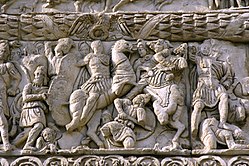Battle of Satala (298)
| Battle of Satala | |||||||
|---|---|---|---|---|---|---|---|
| Part of the Roman-Persian Wars | |||||||
 Detail of Galerius attacking Narseh on the Arch of Galerius at Thessaloniki, Greece |
|||||||
|
|||||||
| Belligerents | |||||||
| Roman Empire | Sassanid Empire | ||||||
| Commanders and leaders | |||||||
| Galerius | Narseh | ||||||
| Strength | |||||||
| Unknown | Unknown | ||||||
| Casualties and losses | |||||||
| Unknown | Unknown, probably very heavy | ||||||
The Battle of Satala was fought in 298, in Armenia, between the forces of the Roman Empire under the Tetrarch Galerius and the forces of the Sassanid Persian ruler Narseh (Narses). The battle was an overwhelming victory for the Roman army, with the Persian army destroyed as a fighting force.
Though traditionally known as the Battle of Satala, the precise location of the battle is not known; the town of Satala may have served as the Roman base of operations. In an early Armenian history it is stated that the battle was fought in the region of Basean, at a village called Osxay. Basean (Phasiana) is usually placed to the east of Erzerum.
In 295 or 296, Narseh declared war on Rome. He appears to have first invaded western Armenia, retaking the lands delivered to King Tiridates III of Armenia in the peace of 287. Narseh then moved south into Roman Mesopotamia, where he inflicted a severe defeat on Galerius, then commander of the Eastern forces, in the region between Carrhae (Harran, Turkey) and Callinicum (Raqqa, Syria).
Galerius had been reinforced, probably in the spring of 298, by a new contingent collected from the empire's best recruiting grounds in Illyricum. Narseh did not advance from Armenia and Mesopotamia, allowing Galerius to take the offensive in 298 with an attack on northern Mesopotamia via Armenia. Narseh withdrew his army into Armenia, which would ensure that Galerius could not move south to attack the Persian capital, Ctesiphon, as it would expose his communications, and nearby Roman provinces, to attack. However, this strategic move was to Narseh's tactical disadvantage: the rugged Armenian terrain was favourable to the Roman army, whose strength was its infantry, but was unfavourable to cavalry operations, in which the Sassanid army excelled. Galerius entered Armenia in company with King Tiridates. Local aid also gave the Romans the advantage of surprise over the Persian forces, and, in two successive battles, Galerius secured victories over Narseh.
...
Wikipedia
